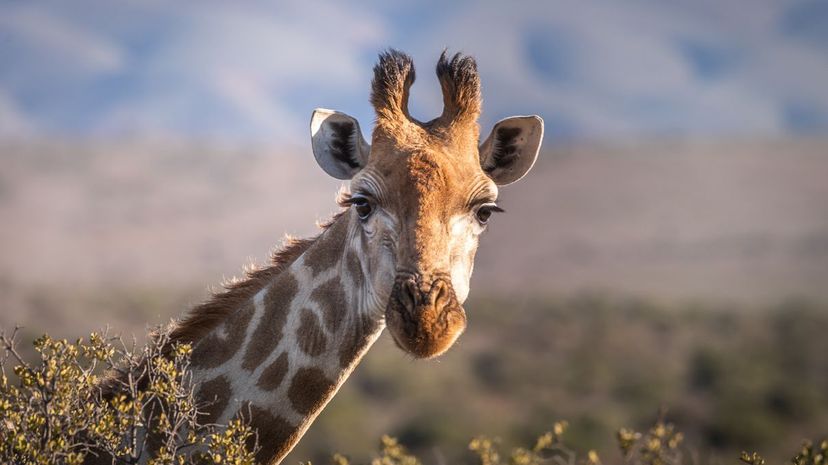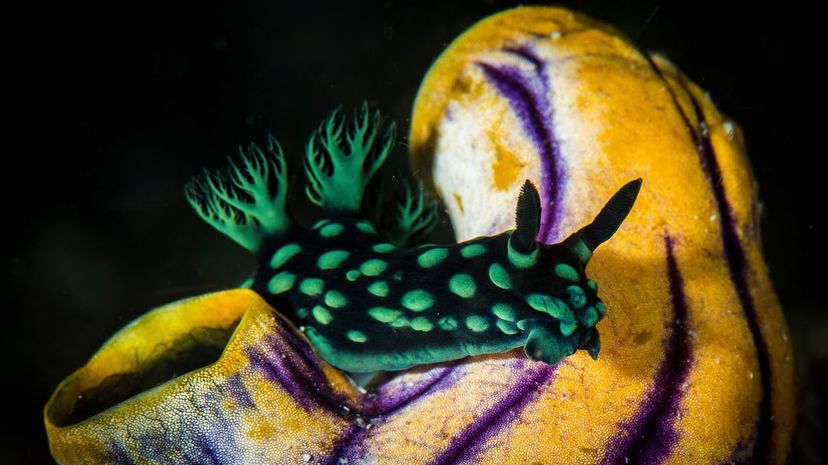
About This Quiz
One of the few things that differentiate humans from every other animal in the kingdom is our lack of spots and stripes. Apparently, humans never needed to camouflage in the wild with spots or stripes.
We do have stripes that are invisible to the naked eye called Blaschko's lines, but being that they're invisible, they're not used for camouflage. Some people have freckles, but those spots can hardly camouflage you in the wild. When it comes to awesome patterns, humans seem to have gotten the shaft, but that's why there are infinite animals in the kingdom for us to gawk at.
Some of the prettiest patterns in the world are formed by animal spots. Some of them are simply surreal. Some animal spots aren't even spots at all. They just look like spots. Some spots function as fingerprints. Some spots function as camouflage. Some spots function for some unknown reason. And some spots are self-explanatory - mostly the neon ones.
Some spots are so neat and uniform, they look like Italian fashion designers designed them. Some animals are stuck with ugly, blotched spots. Whatever the case, the animal kingdom is filled with spots. How well do you know the animal kingdom? Can you identify these animals based on an image of their spots?

Dalmatians develop spots just weeks after birth and develop a full spotted coat within a couple of months. They've historically been known as firehouse dogs since the days of horse-drawn fire wagons. Today they serve more as a firehouse mascot.

Cheetahs are known for their speed and reflexes, and their super abilities come from their claws that only partly retract. These claws are ready to go at all times, and they're stronger than the average cat's claws, allowing cheetahs to turn on a dime at 75 mph.

These slithery sea creatures can grow up to eight feet long and have two sets of jaws. The first set is your normal set of jaws used to snatch prey, and the second set protrudes from their throats to consume prey.
Advertisement

Salamanders come in all shapes, sizes and patterns. They can have two or four legs, be patterned or solid and have lungs or gills. Some baby salamanders don't even have lungs or gills and breathe through thin linings in their mouth and on their throat.

Hyenas are often mistaken for dogs, cats, wolves or a mix between the three, but they're their own species. This spotted species of hyena is known for laughing and hunting, and they usually laugh when they're fighting off others for food.

These horses can be spotted in a multitude of combinations, and some have no pattern at all. The most popular patterns found are marbled, leopard or snowflake patterns, and the horse has been recognized as Idaho's state horse since 1975.
Advertisement

The spotted turtle can have up to 100 yellow spots on its shell, but it might also only have one. These hard-shelled creatures are found along America's entire East Coast but have been endangered since 2012.

It's unknown exactly how the Pietrain pig came to be on Earth, but it was likely a result of selective breeding. This pig is native to Belgium and is known for its lean cuts of meat but is mostly used for breeding purposes.

This freshwater fish is also known as the Xingu River ray, but it's most known for its polka-dot pattern. It was once reported that a polka-dot ray with a mutation sold for $100,000 to an aquarium owner.
Advertisement

A leopard's spotted coat is made of rosettes, which are markings that resemble roses. A cheetah's spots are spots. The rosettes serve for camouflage and are supposed to mimic leaves, grass, sun and shadows as leopards hide and hunt.

The country of India has more than 330 million cows, which outnumbers the human population of the United States, and about 5 million of them are on the loose. The cow has been a scared animal in many religions since the beginning of society.

The smooth and the spotted trunkfish are both spotted, and both contain venom. Other than that, the smooth boxfish has a hard exterior and can grow close to two feet long, making it an undesirable target for other hunters.
Advertisement

These reptiles are found throughout most of Asia and can grow close to two feet long. It's a popular house pet because of its leopard pattern, and it's known to live for 15 years in the wild. They hunt crickets and worms and don't normally scavenge.

A python's spots aren't spots or rosettes but patches of pigment that resemble a spotted pattern. It's a popular pet option for snake lovers because of its pattern and because it's non-venomous. They can still bite but don't normally attack humans.

The official name for a ladybug is a ladybird beetle, and it's a very tiny beetle about half an inch long. They've ruthlessly invaded any land they could, but they're considered to be good luck all over the world.
Advertisement

There are dozens of species of hamadryas, and almost all of them have unique color patterns and spots. The red cracker (hamadryas amphinome) is one of the more striking species of the family and gets its name from the cracking sound it makes.

At 20 feet tall, these are Earth's tallest mammals, and their legs are taller than the average human. The spots are used for camouflage. They're not so helpful for 20-foot tall adults, but they're essential for a newborn's survival. They're also passed down genetically and help identify individuals.

This camouflage pattern might look like several eyes looking back at you if you're a predator. You'll find these in the Southern and Northeastern U.S., but they're originally from Africa and Asia. All 30 or so species of buckeye display similar patterns.
Advertisement

Rule of thumb in the wild is that anything with electric, neon or fluorescent coloring like this is dangerous, and that holds true for this stingray. It doesn't grow wider than two feet, but its tail contains venomous barbs.

This hexagonal pattern serves as ideal camouflage to glide along rocks and coral reef. It's almost invisible in the right conditions, and it spends its time hiding in nooks and eating shrimp and crabs.

Butterflyfish are known to be some of the most striking fish in the world, and all of them have stunning patterns. The peppered butterflyfish is usually spotted black and sports a neon yellow, green and blue fin that resembles a mohawk.
Advertisement

All leopards and jaguars are covered in spots, and black panthers are just leopards and jaguars that produce extra melanin, making their coats black. Some are blacker than others, making it almost impossible to see their spots, but all of them have spots.

You'll find these spotted rascals pouncing on birds, frogs and lizards in the Australian Outback. Most quolls have spots on their body, but the tiger quoll is the only one with spots on its body and tail.

The barred owl is technically streaked, but unless all its feathers are perfectly aligned, it appears spotted. This bird lives on both coasts of the country and is one of the most widespread birds, preying on rats, bats, weasels and more from high above.
Advertisement

The silver-laced wyandotte chicken is a black-and-white American chicken that is raised equally as a show bird and egg layer. Around the world, you'll find a variety of speckled hens unique to their native areas.

Baby white-tailed deer, like Bambi, are spotted, but they lose their spots as they get older. The Indian chital features a reddish-brownish coat of fur covered in white spots. The deer are native to India but were introduced to both Australia and the United States.

The spots on the blue-ringed octopus are technically rings, and they flash fluorescent green when the animal feels threatened. No animal on Earth could mistake this action for an invitation, and the octopus can release some of the most toxic venom on Earth when needed.
Advertisement

The poison dart frog comes in all types of electric colors and patterns, and they're found spotted just as often as they're found striped. The brighter the colors the higher levels of toxicity, and the most toxic of these frogs carry enough poison to kill two African elephants with just one milligram.

This spider gets its name from it ability to jump, but it gets it spots from eight eyes scattered over its body. As expected, the spider has amazing vision and has several vision tricks it can employ for survival in the wild.

These giant spotted moths evolve from woolly bear caterpillars and can grow to two inches in length with a three-inch wingspan. The moth is covered in a combination of solid and empty black circles and can be found everywhere from Ontario to Panama.
Advertisement

The saddleback caterpillar features a distinguishing spot that gives the animal its name, and it's also covered in venomous bristles. Even humans who touch the caterpillar will fall victim to the venom and likely suffer from a painful rash.

This carnivorous snail has a venomous barbed tooth that it sticks into other snails. The venom makes the snail's body go limp, and the marbled cone snail is able to extract the body from the shell and eat its prey.

Sea leopards are also known as leopard seals, and one of the main differences between them and sea lions is that sea lions don't have any spots. These marine mammals can grow up to 10 feet long and 800 pounds heavy.
Advertisement

The African civet isn't fully covered in spots, but its unique pattern lends for an ideal camouflage in the wild. It mostly hunts at night and preys on small mammals, rodents, reptiles, fruits and seeds.

This rare boxfish loves tropical waters and is known for the two soft spines protruding from its fin that resemble horns. As is the case for most animals with neon spots, the fish is poisonous but not venomous.

An ocelot is a wild animal, but some states in America allow it to be kept as a pet. You'll likely need a license for this aggressive and territorial cat that wants to spend its days hunting small mammals, birds and fish. One of these cats can cost more than $15,000 if you're looking for a pet.
Advertisement

The yellow boxfish is yellow and boxed, and if you can't tell from the image, it's essentially a mini-tank swimming around the water. It's covered in a hard shell that makes it a very unpopular option for predators. It also releases lethal toxin from its skin when threatened.

The clown triggerfish is one of the prettiest fish in the sea and is a highly sought-after aquarium addition. These fish can grow to 20 inches in length, and despite their name, they're very serious when it comes to defending their territory and are known to be aggressive.

All of these sea slugs have amazing displays of colors and patterns, but the nembrotha cristata is of the spotted variety. You can't miss its dark-black skin and lime-green markings. The name nudibranch comes from the Latin for nude.
Advertisement

The red-spotted coral crab (trapezia) is a typical guard crab that helps clean and defend coral reefs around the world. It's covered in a neat array of red dots and relies of coral tissue for survival.